LUGANO, SWITZERLAND — Swiss digital asset bank Sygnum has launched a new investment vehicle designed to generate yield on Bitcoin without reducing investors’ exposure to its price movements.
The BTC Alpha Fund, developed in partnership with Athens-based Starboard Digital, uses arbitrage strategies to target net annual returns of 8%-10%, which are paid directly in Bitcoin.
The fund is domiciled in the Cayman Islands and caters to professional and institutional investors. By converting arbitrage gains into bitcoin, participants can increase the number of coins they hold while still benefiting from bitcoin’s long-term price appreciation. Sygnum said the product has already drawn strong interest from clients looking for institutional-grade yield options in digital assets.
The fund comes as institutional investors are looking to go beyond just holding bitcoin in their portfolio and use decentralized finance (DeFi) to generate more income from their BTC holdings. The bitcoin DeFi has gained popularity and has the potential to open up a massive market, according to analysts.
Recently, Binance research noted that only ~0.8% of the bitcoin supply is currently being used in DeFi, implying a potential for a large "untapped opportunity." In fact, last year, Julian Love, a deal analyst at Franklin Templeton Digital Assets, said the opportunity could be as much as $1 trillion.
"Bitcoin has become a key exposure in modern portfolios, and many of our clients want to stay invested while building their positions further," said Markus Hämmerli, who is leading the BTC Alpha Fund offering at Sygnum.
Bitcoin liquidity
For investors, one practical feature is that shares in the new fund can be pledged as collateral for U.S. dollar Lombard loans at Sygnum. This setup allows long-term bitcoin holders to unlock liquidity for other investments without selling down their crypto exposure.
Monthly liquidity and a strict risk management framework are intended to give the fund flexibility while addressing volatility in digital markets. The partnership also leverages Starboard Digital’s background in trading and risk management.
Sygnum has been expanding its bitcoin offerings since launching various initiatives last year. The new fund adds to its growing suite of regulated products aimed at bridging traditional finance and the crypto economy.
#cryptocurrency #blockchain #Jucom #Bitcoin #SwissBank


Lee | Ju.Com
2025-10-24 16:51
🔥 Swiss Bank Sygnum to Launch Bitcoin-Backed Loan Platform With Multi-Sig Wallet Control.
Disclaimer:Contains third-party content. Not financial advice.
See Terms and Conditions.
A Bitcoin wallet dating back to the cryptocurrency’s earliest days has just come to life after more than 14 years of inactivity.
The address, believed to have mined around 4,000 BTC between April and June 2009, transferred 150 BTC this week — the first movement since June 2011.
Rare Movement from the Early Bitcoin Era
The coins, worth just $67,724 when last active, are now valued at roughly $16 million. On-chain data shows the wallet initially consolidated its mined BTC into a single address in 2011 and had remained untouched since.
Transfers from Satoshi-era wallets are extremely rare. Data from Glassnode suggests only a handful of pre-2011 wallets move funds each year.
The coins from this period were mined when Bitcoin’s creator, Satoshi Nakamoto, was still active in online discussions, making such movements a magnet for speculation.
Historically, old-wallet awakenings trigger short-term jitters in the market. Traders often interpret these moves as early holders preparing to sell, sparking fears of large inflows to exchanges.
However, in most past cases, the coins were not sold but simply moved to new addresses for security, inheritance, or consolidation purposes.
Why the Timing Matters
The move comes as Bitcoin trades around $110,000, consolidating after a steep drop from its recent all-time high above $126,000 earlier this month.
The market is recovering from the largest liquidation event in crypto history, with $19 billion wiped out across leveraged positions.
Sentiment remains fragile. Any signal suggesting potential sell pressure — especially from long-dormant wallets — can amplify caution.
Still, the 150 BTC transfer represents a negligible share of daily Bitcoin trading volume, which exceeds $20 billion, making the market impact mostly psychological.
Possible Explanations
There are several plausible reasons behind the move. The owner could be migrating coins to a modern, secure wallet, executing estate planning, or testing transaction functionality.
Unless the funds are later traced to exchange-linked addresses, it is unlikely that the coins were sold.
Similar awakenings in 2021 and 2023 did not lead to sustained price drops. Those transactions were eventually linked to personal reorganization rather than liquidations.
Market Context and Implications
The Bitcoin market has been volatile in recent weeks, shaped by macroeconomic tension and heightened sensitivity to on-chain data.
With prices consolidating between $108,000 and $111,000, traders are looking for direction amid fears of further corrections.
In this environment, old-wallet movements act as symbolic reminders of Bitcoin’s early decentralization — and the immense fortunes still sitting dormant.
For investors, unless these coins reach exchange wallets, such awakenings hold psychological weight, not market-moving power.
Bottom Line
The 14-year-old wallet’s activity is a historic anomaly rather than a harbinger of major market shifts. It reflects Bitcoin’s longevity and the vast untapped wealth from its earliest mining era.
For now, the market continues to watch closely — but the move appears more like digital housekeeping than a signal of imminent selling.
#cryptocurrency #blockchain #Jucom #Satoshi #Bitcoin


Lee | Ju.Com
2025-10-24 16:44
📌 Satoshi-Era Bitcoin Whale Awakens After 14 Years: Will It Move BTC Price?
Disclaimer:Contains third-party content. Not financial advice.
See Terms and Conditions.
🇺🇸 Le géant bancaire JPMorgan accepte désormais le #Bitcoin comme collatéral ! 🚀
💥 Les clients peuvent désormais utiliser $BTC/USDT pour garantir leurs prêts, un pas décisif vers l’adoption institutionnelle de masse.
💡 Cette décision pourrait transformer le marché du crédit crypto et accélérer la fusion entre finance traditionnelle et DeFi.
👉 Quand Wall Street commence à miser sur le Bitcoin… c’est qu’un nouveau cycle vient de s’ouvrir.
#Bitcoin #DeFi #technical analysis
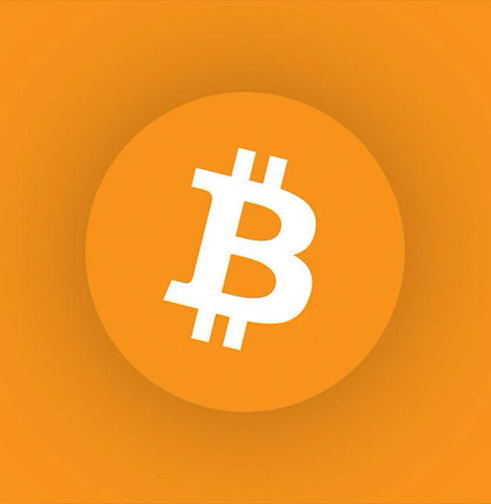



Carmelita
2025-10-24 11:15
🇺🇸 Le géant bancaire JPMorgan accepte désormais
Disclaimer:Contains third-party content. Not financial advice.
See Terms and Conditions.
What Is the Total Number of Transactions on the Bitcoin Network?
Understanding the total number of transactions on the Bitcoin network is essential for grasping how active and widely used this pioneering cryptocurrency truly is. This metric offers insights into user engagement, network health, and overall adoption trends. In this article, we will explore what influences transaction volume, recent developments in 2023, and what these figures mean for investors and users alike.
How Does Transaction Volume Reflect Network Activity?
The total number of Bitcoin transactions indicates how frequently users are transferring funds or engaging with blockchain-based applications. On average, as of 2023, around 250,000 to 300,000 transactions occur daily. These fluctuations are driven by various factors such as market sentiment—bullish periods tend to see increased activity—as well as regulatory environments that can either encourage or restrict usage.
High transaction volumes suggest a vibrant ecosystem where users actively buy, sell, or transfer Bitcoin. Conversely, dips may signal reduced interest or external pressures like stricter regulations. Monitoring these numbers helps stakeholders gauge whether Bitcoin remains a popular medium for peer-to-peer payments or speculative trading.
Factors Influencing Transaction Counts
Several key elements impact how many transactions are recorded on the blockchain:
- Market Conditions: Bull markets often lead to increased trading activity as investors seek opportunities.
- Regulatory Changes: Stricter laws can temporarily suppress transaction volumes; conversely, favorable policies may boost activity.
- Network Congestion: When many users transact simultaneously—such as during major price swings—transaction fees rise due to limited block space.
- Technological Developments: Improvements like SegWit (Segregated Witness) have optimized transaction processing times and costs over time.
These factors collectively shape daily transaction counts and influence user behavior across different periods.
Recent Trends in 2023: Fluctuations in Transaction Numbers
In April 2023, the Bitcoin network experienced a notable surge in transaction volume driven by heightened market speculation amid potential regulatory shifts in major economies. This increase was partly fueled by traders reacting to news about possible government interventions that could impact cryptocurrency markets globally.
However, May saw an uptick in average transaction fees—about a 20% rise compared to previous months—which reflects higher network congestion. Elevated fees can discourage smaller transactions from occurring frequently because they become less cost-effective for everyday use cases like micro-payments or casual transfers.
These recent trends highlight how external events directly influence not only how much activity occurs but also its economic viability for typical users.
Blockchain Size and Its Impact on Transactions
The size of the Bitcoin blockchain itself provides context about overall network activity; it stood at approximately 400 GB in early 2023—a significant increase from previous years due to continuous addition of new blocks containing transactional data.
A larger blockchain signifies more historical data stored across nodes worldwide but also raises concerns regarding scalability:
- Larger blockchains require more storage capacity.
- Synchronization times increase for new nodes joining the network.
- Higher data loads can contribute to slower confirmation times during peak periods unless scaling solutions are implemented effectively.
Efforts such as Lightning Network aim to address these scalability challenges by enabling faster off-chain transactions while maintaining security through underlying blockchain settlement layers.
The Role of Miners and Validation Processes
Miners play a crucial role in maintaining accurate records by validating transactions through complex computational puzzles—a process known as proof-of-work (PoW). They compete within seconds to add new blocks containing pending transactions onto the chain; successful miners receive rewards plus associated fees paid by transacting parties.
This validation process ensures integrity but is energy-intensive: estimates suggest that mining consumes substantial electricity globally. As demand increases with higher transaction volumes during active periods like April-May 2023’s surge,
the environmental footprint becomes more prominent concern among regulators and advocates alike.
Key Points About Mining:
- Miners validate hundreds of thousands of daily transactions
- Validation ensures decentralization & security
- Rising demand impacts energy consumption
Regulatory Environment's Effect on Transaction Volumes
Government policies significantly influence user participation levels on the Bitcoin network. In early 2023,
several countries introduced stricter regulations targeting crypto exchanges,which temporarily dampened trading activities reflected through decreased transaction counts initially observed after policy announcements.
However,
some jurisdictions adopted clearer frameworks encouraging institutional involvement,potentially stabilizing or increasing future transactional activity once compliance mechanisms were established.
Summary:
Regulatory uncertainty remains one of the most unpredictable factors affecting total bitcoin transactions; ongoing legislative developments will continue shaping usage patterns moving forward.
Future Outlook: Scalability Solutions & Adoption Trends
As interest grows among retail investors and institutions alike,
scalability solutions such as Taproot upgrades,Lightning Network implementations,and sidechains aim to facilitate faster processing at lower costs.
These technological advancements could help sustain higher throughput levels necessary for mainstream adoption while reducing congestion-related fee hikes seen earlier this year.
Moreover,
wider acceptance from merchants accepting bitcoin payments directly enhances real-world utility beyond speculative trading,
potentially leading toward sustained growth in total number of daily transactions over coming years.
By continuously monitoring metrics like total bitcoin transaction count alongside technological improvements and regulatory changes,
stakeholders—from individual users to large-scale investors—can better understand market dynamics
and make informed decisions aligned with evolving industry conditions.
References
- CoinDesk — General information on Bitcoin networks
- Blockchain.com Charts — Historical data analysis
- Blockchain Size Data — Blockchain growth insights
- Transaction Fees & Congestion — Impact analysis
- Bitcoin Mining Process — Technical validation overview
- Regulatory Impact Reports — Policy effects assessment
Understanding how many people transact using Bitcoin provides valuable insight into its current state—and future potential—as both an investment asset and a decentralized payment system amidst an ever-changing global landscape


Lo
2025-05-06 07:37
What is the total number of transactions on the Bitcoin network?
What Is the Total Number of Transactions on the Bitcoin Network?
Understanding the total number of transactions on the Bitcoin network is essential for grasping how active and widely used this pioneering cryptocurrency truly is. This metric offers insights into user engagement, network health, and overall adoption trends. In this article, we will explore what influences transaction volume, recent developments in 2023, and what these figures mean for investors and users alike.
How Does Transaction Volume Reflect Network Activity?
The total number of Bitcoin transactions indicates how frequently users are transferring funds or engaging with blockchain-based applications. On average, as of 2023, around 250,000 to 300,000 transactions occur daily. These fluctuations are driven by various factors such as market sentiment—bullish periods tend to see increased activity—as well as regulatory environments that can either encourage or restrict usage.
High transaction volumes suggest a vibrant ecosystem where users actively buy, sell, or transfer Bitcoin. Conversely, dips may signal reduced interest or external pressures like stricter regulations. Monitoring these numbers helps stakeholders gauge whether Bitcoin remains a popular medium for peer-to-peer payments or speculative trading.
Factors Influencing Transaction Counts
Several key elements impact how many transactions are recorded on the blockchain:
- Market Conditions: Bull markets often lead to increased trading activity as investors seek opportunities.
- Regulatory Changes: Stricter laws can temporarily suppress transaction volumes; conversely, favorable policies may boost activity.
- Network Congestion: When many users transact simultaneously—such as during major price swings—transaction fees rise due to limited block space.
- Technological Developments: Improvements like SegWit (Segregated Witness) have optimized transaction processing times and costs over time.
These factors collectively shape daily transaction counts and influence user behavior across different periods.
Recent Trends in 2023: Fluctuations in Transaction Numbers
In April 2023, the Bitcoin network experienced a notable surge in transaction volume driven by heightened market speculation amid potential regulatory shifts in major economies. This increase was partly fueled by traders reacting to news about possible government interventions that could impact cryptocurrency markets globally.
However, May saw an uptick in average transaction fees—about a 20% rise compared to previous months—which reflects higher network congestion. Elevated fees can discourage smaller transactions from occurring frequently because they become less cost-effective for everyday use cases like micro-payments or casual transfers.
These recent trends highlight how external events directly influence not only how much activity occurs but also its economic viability for typical users.
Blockchain Size and Its Impact on Transactions
The size of the Bitcoin blockchain itself provides context about overall network activity; it stood at approximately 400 GB in early 2023—a significant increase from previous years due to continuous addition of new blocks containing transactional data.
A larger blockchain signifies more historical data stored across nodes worldwide but also raises concerns regarding scalability:
- Larger blockchains require more storage capacity.
- Synchronization times increase for new nodes joining the network.
- Higher data loads can contribute to slower confirmation times during peak periods unless scaling solutions are implemented effectively.
Efforts such as Lightning Network aim to address these scalability challenges by enabling faster off-chain transactions while maintaining security through underlying blockchain settlement layers.
The Role of Miners and Validation Processes
Miners play a crucial role in maintaining accurate records by validating transactions through complex computational puzzles—a process known as proof-of-work (PoW). They compete within seconds to add new blocks containing pending transactions onto the chain; successful miners receive rewards plus associated fees paid by transacting parties.
This validation process ensures integrity but is energy-intensive: estimates suggest that mining consumes substantial electricity globally. As demand increases with higher transaction volumes during active periods like April-May 2023’s surge,
the environmental footprint becomes more prominent concern among regulators and advocates alike.
Key Points About Mining:
- Miners validate hundreds of thousands of daily transactions
- Validation ensures decentralization & security
- Rising demand impacts energy consumption
Regulatory Environment's Effect on Transaction Volumes
Government policies significantly influence user participation levels on the Bitcoin network. In early 2023,
several countries introduced stricter regulations targeting crypto exchanges,which temporarily dampened trading activities reflected through decreased transaction counts initially observed after policy announcements.
However,
some jurisdictions adopted clearer frameworks encouraging institutional involvement,potentially stabilizing or increasing future transactional activity once compliance mechanisms were established.
Summary:
Regulatory uncertainty remains one of the most unpredictable factors affecting total bitcoin transactions; ongoing legislative developments will continue shaping usage patterns moving forward.
Future Outlook: Scalability Solutions & Adoption Trends
As interest grows among retail investors and institutions alike,
scalability solutions such as Taproot upgrades,Lightning Network implementations,and sidechains aim to facilitate faster processing at lower costs.
These technological advancements could help sustain higher throughput levels necessary for mainstream adoption while reducing congestion-related fee hikes seen earlier this year.
Moreover,
wider acceptance from merchants accepting bitcoin payments directly enhances real-world utility beyond speculative trading,
potentially leading toward sustained growth in total number of daily transactions over coming years.
By continuously monitoring metrics like total bitcoin transaction count alongside technological improvements and regulatory changes,
stakeholders—from individual users to large-scale investors—can better understand market dynamics
and make informed decisions aligned with evolving industry conditions.
References
- CoinDesk — General information on Bitcoin networks
- Blockchain.com Charts — Historical data analysis
- Blockchain Size Data — Blockchain growth insights
- Transaction Fees & Congestion — Impact analysis
- Bitcoin Mining Process — Technical validation overview
- Regulatory Impact Reports — Policy effects assessment
Understanding how many people transact using Bitcoin provides valuable insight into its current state—and future potential—as both an investment asset and a decentralized payment system amidst an ever-changing global landscape
Disclaimer:Contains third-party content. Not financial advice.
See Terms and Conditions.
Crypto taxation varies dramatically worldwide - the same transaction could be tax-free in one country but heavily taxed in another. Understanding these differences is crucial for compliance and portfolio management.
🌍 Key Global Differences:
-
Property Classification: US treats crypto as property - both crypto-to-crypto trades and purchases trigger capital gains
Holding Period Matters: US short-term gains (≤1 year) taxed up to 37%, long-term gains 0-20%
Tax-Free Holdings: Germany - completely tax-free after 1 year holding, up to €600 profit exempt under 1 year
Recent Changes: Portugal introduced 28% tax on short-term gains, but 1+ year holdings remain tax-exempt
🏝️ Crypto Tax Havens:
-
UAE: 0% personal income tax on crypto gains for individuals
Key Requirement: Must establish tax residency (typically 183+ days/year)
US Citizens Warning: Worldwide income taxation applies regardless of residence
📊 Tax Categories:
-
Capital Gains: Triggered by selling, trading, or spending crypto
Income Tax: Applied to mining, staking rewards, airdrops, and crypto payments
⚠️ Compliance Challenges:
-
Every crypto-to-crypto trade is a taxable event in most countries
Must track date, value, and cost basis for each transaction
US introducing Form 1099-DA for automated exchange reporting
Specialized software recommended for transaction tracking
💡 Pro Tips:
-
Use FIFO or Specific Identification accounting methods to minimize liability
Crypto losses can offset gains in most jurisdictions
Simply holding (HODLing) crypto is not taxable
Professional tax advice essential for international compliance
Bottom Line: Crypto taxation is far from uniform globally. Your tax liability depends heavily on your jurisdiction, holding period, and transaction type. Stay compliant by understanding your local laws and maintaining detailed records.
Read the complete guide with detailed country breakdowns and compliance strategies: 👇 https://blog.jucoin.com/crypto-taxation-global-differences-tax-guide/?utm_source=blog
#CryptoTax #Taxation #Bitcoin #Cryptocurrency


JU Blog
2025-08-16 08:44
💰 Crypto Taxation: Global Differences & Tax Guide 2025
Disclaimer:Contains third-party content. Not financial advice.
See Terms and Conditions.
🚀 Latest Bitcoin Price Predictions: Bull Run to Continue in 2025!
With Bitcoin currently trading around $113,762, experts are overwhelmingly bullish on BTC's future prospects. Here's what the latest analysis reveals about Bitcoin's price trajectory:
💰 2025 Price Targets:
-
Conservative estimates: $120,000 - $135,000
Bullish predictions: $150,000 - $175,000
Ultra-bullish: Up to $230,000 (Digital Coin Price)
Cathie Wood (Ark Invest): Path to $1 million within 5 years
📈 Key Price Predictions by Year:
-
2025: Average $125,027 (range: $84,643 - $181,064)
2026: Average $111,187 (range: $95,241 - $150,000)
2030: Average $266,129 (range: $198,574 - $500,000)
Long-term: Some analysts predict $900K+ by 2030
🎯 What's Driving the Bullish Outlook:
-
Post-halving momentum (April 2024 halving reducing supply)
Massive institutional adoption via Bitcoin ETFs
Growing acceptance as digital gold and inflation hedge
Potential Federal Reserve rate cuts boosting risk assets
Strong political support and clearer regulations
📊 Technical Analysis Insights:
-
200-day moving average trending upward since January 2025
Current RSI in neutral zone (30-70), indicating room for growth
Fear & Greed Index at 50 (neutral), historically preceding rebounds
14/30 green days in the last month showing resilience
⚡ Key Catalysts to Watch:
-
Bitcoin ETF approvals at major wirehouses (Q3-Q4 2025)
Institutional "basis trade" adoption accelerating
Potential shift from retail to institutional investor flows
Macroeconomic stability supporting risk-on sentiment
🔮 Expert Highlights:
-
Bernstein: Revised target from $150K to $200K by end-2025
PlanB: Stock-to-flow model suggests $1M possible by 2025
Bloomberg: Conservative $100K target based on historical cycles
Chamath Palihapitiya: $500K by October 2025
⚠️ Risk Factors:
-
High volatility remains (1.78% daily price swings)
Regulatory uncertainties in various jurisdictions
Competition from other cryptocurrencies
Macroeconomic headwinds and geopolitical tensions
Bottom Line: Despite short-term volatility, the consensus among analysts points to continued Bitcoin appreciation driven by institutional adoption, post-halving dynamics, and its growing role as a digital store of value. The next 12-18 months could be pivotal for BTC reaching new all-time highs.
Current market conditions suggest this could be an opportune time for long-term investors, though as always, conduct your own research and invest responsibly.
Read more detailed analysis and expert insights: 👇 https://blog.jucoin.com/what-are-the-latest-bitcoin-price-predictions/?utm_source=blog
#Bitcoin #BTC


JU Blog
2025-08-22 11:03
Bitcoin Price Predictions 2025: Navigating the Bull Market
Disclaimer:Contains third-party content. Not financial advice.
See Terms and Conditions.
Two leading Federal Reserve chair candidates are advocating aggressive rate cuts despite inflation concerns, potentially creating powerful tailwinds for cryptocurrency markets. With Trump considering 11 candidates to replace Jerome Powell in May 2026, dovish monetary policy could drive substantial crypto gains.
🏛️ Leading Dovish Candidates:
-
Marc Sumerlin: Former Bush admin economist advocating 50+ basis point cuts
David Zervos: Jefferies Chief Market Strategist supporting 200+ basis point total reduction
Key Position: Both believe current monetary policy is "offensively tight" despite PPI data
Trump Alignment: Both support lower borrowing costs and economic stimulus
📈 How Rate Cuts Boost Crypto:
-
Lower Opportunity Costs: Reduced bond/savings yields push investors toward crypto
Increased Liquidity: More money flowing into alternative investments
Dollar Weakness: Makes Bitcoin more attractive as store of value
Risk Appetite: Cheaper borrowing costs encourage higher-yield asset allocation
Historical Precedent: 2020-2021 crypto rally coincided with Fed accommodation
💎 Crypto Market Benefits:
-
Bitcoin: Enhanced digital store of value appeal during dollar weakness
Ethereum: Increased DeFi activity from improved liquidity conditions
Layer-1 Protocols: More developer activity and ecosystem growth
Infrastructure: Crypto companies access cheaper capital for expansion
Stablecoins: Expanded usage in lower-rate environments
🔍 Selection Process Impact:
-
11 Candidates: Diverse backgrounds from Fed officials to market strategists
Timeline: Prolonged uncertainty could create short-term volatility
Market Experience: Candidates like Zervos bring crypto-aware perspectives
Policy Clarity: Dovish positioning provides directional support regardless of final pick
📊 Historical Correlation:
-
2022 Struggle: Crypto fell as rates rose aggressively
2023-2024 Recovery: Crypto rallied as rate hikes peaked and cuts expected
Transmission Speed: Crypto markets react immediately to Fed policy changes
Sustained Impact: Rate cut campaigns provide ongoing support over months
⚠️ Key Considerations:
-
Regulatory uncertainty remains despite monetary tailwinds
Timing matters - gradual vs aggressive cuts create different market dynamics
Fed chair's approach to financial stability could impact crypto oversight
Monetary policy alone cannot drive sustained crypto adoption
🎯 Investment Implications: The combination of dovish Fed leadership and Trump's pro-crypto stance creates potentially explosive conditions for digital assets. Lower rates reduce competition from traditional investments while institutional appetite for alternatives increases dramatically.
Bottom Line: Fed chair candidates advocating aggressive rate cuts could unleash massive liquidity into crypto markets. Historical data shows strong correlations between accommodative monetary policy and crypto rallies. The May 2026 appointment could mark a pivotal moment for digital asset adoption.
Read the complete analysis on Fed chair candidates and crypto market implications: 👇 https://blog.jucoin.com/fed-chair-rate-cuts-crypto/?utm_source=blog
#FedChair #RateCuts #Crypto #Bitcoin #Ethereum


JU Blog
2025-08-16 08:50
💰 Fed Chair Rate Cuts Could Spark Massive Crypto Rally
Disclaimer:Contains third-party content. Not financial advice.
See Terms and Conditions.
When will Bitcoin go back up? He’s been saying “trust me bro” for years… now he’s saying it in a nursing home 🧓. Still waiting for that mythical alt season 🔮
Check out our YouTube Channel 👉
#Bitcoin #CryptoMeme #CryptoHumor


Ju.com Media
2025-08-06 11:52
⏳ When Will Bitcoin Go Back Up? Trust Me, Bro, It’s Coming
Disclaimer:Contains third-party content. Not financial advice.
See Terms and Conditions.
The crypto market experienced significant losses in August 2025, with most major tokens posting notable declines. Here's what's driving the downturn and what investors need to know:
💰 Major Losses Overview:
-
Bitcoin (BTC): -8% to $113,562
Ethereum (ETH): -5.2% to $4,166
Cardano (ADA): -6.3% to $0.8526
XRP: -3.77% to $2.89
Dogecoin (DOGE): -2.21% to $0.2127
🎯 Key Market Drivers:
1️⃣ Jackson Hole Uncertainty: Fed rate cut expectations dropped from 98% to 15%, dampening institutional risk appetite
2️⃣ ETF Volatility: Ethereum ETFs saw $196.6 million outflows after a record $2.8 billion inflow the previous week
3️⃣ Regulatory Delays: Stalled altcoin ETF approvals and unclear stablecoin legislation adding market anxiety
4️⃣ Technical Liquidations: Over $1.2 billion in long positions liquidated as Bitcoin hit resistance at $124,000
🚨 Security Concerns:
-
AI-powered wallet drainers targeting developers
$2.17 billion in crypto hacks recorded in 2025
GreedyBear exploit affecting 150+ fake browser extensions
🏆 Biggest Altcoin Losers (24h):
-
Gari Network (GARI): -23.15%
Useless Coin (USELESS): -17.98%
League of Kingdoms Arena (LOKA): -10.03%
Livepeer (LPT): -9.90%
💡 What's Next:
-
All eyes on Powell's Jackson Hole speech for Fed policy signals
ETF flows remain key indicator for short-term price action
Most analysts view this as temporary correction, not trend reversal
Long-term fundamentals remain intact despite current volatility
The market correction appears driven by macro uncertainty rather than fundamental crypto weaknesses. Investors are consolidating positions ahead of key policy announcements.
Read the complete market analysis with detailed charts and expert insights: 👇 https://blog.jucoin.com/crypto-losses-recent-key-market-declines-explained/
#CryptoLosses #Bitcoin #Ethereum


JU Blog
2025-08-20 10:37
📉 Crypto Market Takes Sharp Hit: Major Tokens Down 3-8% This Week
Disclaimer:Contains third-party content. Not financial advice.
See Terms and Conditions.
Altcoin season is a market phase where cryptocurrencies other than Bitcoin significantly outperform BTC, offering substantial growth opportunities for savvy investors. Here's your complete navigation guide:
💡 What is Altcoin Season:
-
Period when altcoins outperform Bitcoin's market performance
Characterized by declining Bitcoin dominance index
Driven by capital rotation from Bitcoin to higher-risk, higher-reward assets
Part of the broader cryptocurrency market cycle
🎯 Key Signs to Spot the Beginning:
1️⃣ Bitcoin Dominance Index (BTC.D): Watch for sustained decline - most reliable indicator 2️⃣ Altcoin Season Index: Signals season when 75% of top 100 altcoins outperform Bitcoin over 90 days 3️⃣ Increased Trading Volume: Surge in altcoin trading, especially mid to small-cap assets 4️⃣ Capital Rotation Pattern: Money flows from Bitcoin → Large-cap alts → Mid-cap → Small-cap
⏰ Duration & Patterns:
-
Varies from few weeks to several months
Historically ranges based on market catalysts (ICO boom 2017-2018, DeFi/NFT surge 2021)
Intensity depends on overall bull market strength
🏆 Navigation Strategy:
Capital Flow Cycle:
-
Bitcoin bull run & consolidation
Large-cap altcoins (Ethereum) gain momentum
Mid-cap altcoins follow
Small-cap altcoins experience parabolic gains
Risk Management:
-
Diversify across different sectors
Monitor market sentiment and key developments
Have clear profit-taking strategy
Prepare for high volatility
💰 Investment Opportunities:
-
DeFi projects during sector rotation
Gaming tokens and NFT platforms
Emerging blockchain technologies
Meme coins (high-risk, high-reward)
⚠️ Important Notes:
-
Cannot predict with 100% certainty
High volatility and risk involved
"Popcorn effect" - coins rally in random bursts
Stay informed on market developments
With proper understanding of these cycles and indicators, investors can position themselves to potentially capitalize on the dynamic opportunities presented by altcoin season.
Read the complete guide with detailed analysis and historical examples: 👇 https://blog.jucoin.com/learn-what-altcoin-season-is-and-how-to-navigate/?utm_source=blog
#AltcoinSeason #Bitcoin #Cryptocurrency #Trading #Investment #DeFi #Altcoins #CryptoMarket #BitcoinDominance #JuCoin #Web3 #Blockchain #TradingStrategy #CryptoInvesting #MarketCycle


JU Blog
2025-08-14 10:55
🚀 What is Altcoin Season and How to Navigate It?
Disclaimer:Contains third-party content. Not financial advice.
See Terms and Conditions.
How Is the Development Process for the Bitcoin Core Client Managed?
The development of the Bitcoin Core client is a cornerstone of maintaining the security, stability, and innovation within the Bitcoin network. As an open-source project, it relies heavily on a community-driven approach that emphasizes transparency and collaborative effort. Anyone with programming skills can contribute to its codebase, which fosters a diverse pool of developers from around the world. This inclusivity ensures that multiple perspectives are considered when implementing new features or fixing bugs.
The process begins with proposals for changes known as Bitcoin Improvement Proposals (BIPs). These are detailed documents suggesting modifications to enhance functionality or security. Once a BIP is drafted, it undergoes rigorous review by experienced developers through pull requests on GitHub—a platform central to managing contributions. Each proposed change must pass thorough code reviews to ensure adherence to quality standards and prevent vulnerabilities.
Bitcoin Core follows a structured release cycle typically every six months. This regular schedule allows for systematic updates that include bug fixes, performance improvements, and sometimes new features like privacy enhancements or scalability solutions. Before any release goes live, comprehensive testing—both automated and manual—is conducted across various environments to verify stability and security integrity.
Continuous integration tools play an essential role in early detection of issues during development stages. They automatically run tests whenever code changes are submitted, helping maintain high-quality standards throughout the project lifecycle. The collaborative nature combined with disciplined processes ensures that Bitcoin Core remains robust against potential threats while evolving in response to technological advancements.
Funding Mechanisms Supporting Bitcoin Core Development
Sustaining ongoing development efforts requires significant financial resources; however, unlike many proprietary software projects, Bitcoin Core relies predominantly on community-based funding models rather than corporate sponsorships alone. Donations from individual users form one of its primary income streams—these voluntary contributions help cover operational costs such as server hosting and developer stipends.
In addition to direct donations from enthusiasts worldwide, grants also play an important role in supporting specific initiatives within the project’s roadmap. Various organizations dedicated to advancing blockchain technology provide targeted funding for research or feature implementation efforts aligned with their strategic goals.
Corporate sponsorships further bolster development capacity by financially supporting key contributors who work full-time on core improvements. Notable companies like Blockstream and Chaincode Labs sponsor individual developers or entire teams involved in critical areas such as scalability upgrades or security enhancements—this model helps attract talent capable of handling complex technical challenges efficiently.
Bitcoin Improvement Proposals (BIPs) often require substantial resources when they introduce significant protocol changes—for example, upgrades like Taproot—which improve transaction privacy and efficiency have been funded through this combination of donations and sponsorships over recent years.
Recent Developments Shaping Bitcoin Core’s Future
Over recent years, several major upgrades have marked milestones in enhancing Bitcoin's capabilities through core development efforts backed by community support:
Taproot Upgrade (2021): One of the most notable advancements was implementing Taproot—a protocol upgrade designed to improve transaction privacy while increasing scalability options on-chain. Its successful deployment was made possible through coordinated community funding efforts involving both donations from users keen on improving network efficiency—and sponsorships from organizations committed to long-term sustainability.
SegWit2x Controversy: In 2017 there was significant debate surrounding SegWit2x—a proposed hard fork intended initially for increasing block size limits—but faced opposition due mainly to concerns about decentralization risks and security implications among different stakeholder groups within the ecosystem leading ultimately toward abandonment in favor of Segregated Witness (SegWit). This episode underscored how community consensus—or lack thereof—can influence development trajectories.
Lightning Network Integration: Ongoing work aims at integrating off-chain solutions like Lightning Network into core software infrastructure—to facilitate faster transactions at lower fees without congesting main chain blocks—highlighting continuous innovation driven by collaborative effort.
Security Enhancements: The team actively works on fortifying wallet management systems against emerging threats such as 51% attacks while improving resistance mechanisms overall—a vital aspect given cryptocurrency's value proposition as digital gold.
These developments exemplify how collective input—from volunteers’ coding contributions supported by organizational backing—drives forward-looking improvements aligned with user needs for increased privacy, speed, safety—and broader adoption potential.
Challenges Facing Development Funding & Community Dynamics
Despite its strengths rooted in openness and collaboration—the decentralized nature introduces unique challenges:
Community Disagreements: Divergent opinions among stakeholders regarding technical directions can cause delays or fragmentation within development teams—as seen during controversies like SegWit2x—that may hinder timely progress.
Funding Uncertainty: Heavy reliance on voluntary donations means fluctuations can impact resource availability; if donor interest wanes or organizational priorities shift away from supporting core devs financially—project momentum might slow down.
Regulatory Pressures: As governments worldwide tighten regulations around cryptocurrencies—including anti-money laundering measures—they could impose restrictions affecting donation channels or create legal uncertainties impacting open-source projects’ operations globally.
Addressing these issues requires transparent governance structures coupled with diversified funding strategies—including institutional partnerships—to ensure resilience amid evolving external pressures.
How Open Source Principles Ensure Security & Transparency
One key reason behind Bitcoin’s resilience lies in its open-source foundation: anyone can scrutinize source code for vulnerabilities; this transparency fosters trustworthiness crucial for financial systems handling billions worth of assets daily. Regular peer reviews enable rapid identification—and patching—of bugs before exploitation occurs; this collective vigilance enhances overall network robustness over time.
Furthermore: active engagement from global developer communities accelerates innovation cycles while maintaining high-security standards necessary under E-A-T principles (Expertise–Authoritativeness–Trustworthiness). By openly sharing updates via repositories like GitHub—and documenting decision-making processes transparently—the project builds credibility among users ranging from casual investors up through institutional stakeholders seeking reliable infrastructure.
Future Outlook: Sustaining Innovation Amid Challenges
Looking ahead involves balancing continuous technological advancement with sustainable funding models amidst regulatory landscapes shifting globally:
- Increasing integration between Lightning Network solutions promises faster payments suitable even for microtransactions
- Privacy-focused features will likely remain priorities given rising demand
- Efforts toward decentralizing governance could mitigate risks associated with concentrated influence
To sustain momentum:
- Maintaining diverse sources of support—including grants alongside donations—is essential
- Fostering inclusive participation across geographies enhances resilience
- Emphasizing transparent decision-making aligns well with user expectations rooted in trust
By adhering closely to open-source best practices combined with innovative technical roadmaps supported by broad-based backing—all underpinned by strong ethical standards—the future looks promising despite inevitable hurdles.
This overview provides clarity into how foundational principles shape ongoing developments within Bitcoin Core—from management practices grounded in transparency & collaboration—to funding strategies ensuring sustained growth amid external pressures—all vital components underpinning one of today’s most influential blockchain projects worldwide


JCUSER-F1IIaxXA
2025-05-11 06:09
How is the development process for the Bitcoin (BTC) Core client managed and funded?
How Is the Development Process for the Bitcoin Core Client Managed?
The development of the Bitcoin Core client is a cornerstone of maintaining the security, stability, and innovation within the Bitcoin network. As an open-source project, it relies heavily on a community-driven approach that emphasizes transparency and collaborative effort. Anyone with programming skills can contribute to its codebase, which fosters a diverse pool of developers from around the world. This inclusivity ensures that multiple perspectives are considered when implementing new features or fixing bugs.
The process begins with proposals for changes known as Bitcoin Improvement Proposals (BIPs). These are detailed documents suggesting modifications to enhance functionality or security. Once a BIP is drafted, it undergoes rigorous review by experienced developers through pull requests on GitHub—a platform central to managing contributions. Each proposed change must pass thorough code reviews to ensure adherence to quality standards and prevent vulnerabilities.
Bitcoin Core follows a structured release cycle typically every six months. This regular schedule allows for systematic updates that include bug fixes, performance improvements, and sometimes new features like privacy enhancements or scalability solutions. Before any release goes live, comprehensive testing—both automated and manual—is conducted across various environments to verify stability and security integrity.
Continuous integration tools play an essential role in early detection of issues during development stages. They automatically run tests whenever code changes are submitted, helping maintain high-quality standards throughout the project lifecycle. The collaborative nature combined with disciplined processes ensures that Bitcoin Core remains robust against potential threats while evolving in response to technological advancements.
Funding Mechanisms Supporting Bitcoin Core Development
Sustaining ongoing development efforts requires significant financial resources; however, unlike many proprietary software projects, Bitcoin Core relies predominantly on community-based funding models rather than corporate sponsorships alone. Donations from individual users form one of its primary income streams—these voluntary contributions help cover operational costs such as server hosting and developer stipends.
In addition to direct donations from enthusiasts worldwide, grants also play an important role in supporting specific initiatives within the project’s roadmap. Various organizations dedicated to advancing blockchain technology provide targeted funding for research or feature implementation efforts aligned with their strategic goals.
Corporate sponsorships further bolster development capacity by financially supporting key contributors who work full-time on core improvements. Notable companies like Blockstream and Chaincode Labs sponsor individual developers or entire teams involved in critical areas such as scalability upgrades or security enhancements—this model helps attract talent capable of handling complex technical challenges efficiently.
Bitcoin Improvement Proposals (BIPs) often require substantial resources when they introduce significant protocol changes—for example, upgrades like Taproot—which improve transaction privacy and efficiency have been funded through this combination of donations and sponsorships over recent years.
Recent Developments Shaping Bitcoin Core’s Future
Over recent years, several major upgrades have marked milestones in enhancing Bitcoin's capabilities through core development efforts backed by community support:
Taproot Upgrade (2021): One of the most notable advancements was implementing Taproot—a protocol upgrade designed to improve transaction privacy while increasing scalability options on-chain. Its successful deployment was made possible through coordinated community funding efforts involving both donations from users keen on improving network efficiency—and sponsorships from organizations committed to long-term sustainability.
SegWit2x Controversy: In 2017 there was significant debate surrounding SegWit2x—a proposed hard fork intended initially for increasing block size limits—but faced opposition due mainly to concerns about decentralization risks and security implications among different stakeholder groups within the ecosystem leading ultimately toward abandonment in favor of Segregated Witness (SegWit). This episode underscored how community consensus—or lack thereof—can influence development trajectories.
Lightning Network Integration: Ongoing work aims at integrating off-chain solutions like Lightning Network into core software infrastructure—to facilitate faster transactions at lower fees without congesting main chain blocks—highlighting continuous innovation driven by collaborative effort.
Security Enhancements: The team actively works on fortifying wallet management systems against emerging threats such as 51% attacks while improving resistance mechanisms overall—a vital aspect given cryptocurrency's value proposition as digital gold.
These developments exemplify how collective input—from volunteers’ coding contributions supported by organizational backing—drives forward-looking improvements aligned with user needs for increased privacy, speed, safety—and broader adoption potential.
Challenges Facing Development Funding & Community Dynamics
Despite its strengths rooted in openness and collaboration—the decentralized nature introduces unique challenges:
Community Disagreements: Divergent opinions among stakeholders regarding technical directions can cause delays or fragmentation within development teams—as seen during controversies like SegWit2x—that may hinder timely progress.
Funding Uncertainty: Heavy reliance on voluntary donations means fluctuations can impact resource availability; if donor interest wanes or organizational priorities shift away from supporting core devs financially—project momentum might slow down.
Regulatory Pressures: As governments worldwide tighten regulations around cryptocurrencies—including anti-money laundering measures—they could impose restrictions affecting donation channels or create legal uncertainties impacting open-source projects’ operations globally.
Addressing these issues requires transparent governance structures coupled with diversified funding strategies—including institutional partnerships—to ensure resilience amid evolving external pressures.
How Open Source Principles Ensure Security & Transparency
One key reason behind Bitcoin’s resilience lies in its open-source foundation: anyone can scrutinize source code for vulnerabilities; this transparency fosters trustworthiness crucial for financial systems handling billions worth of assets daily. Regular peer reviews enable rapid identification—and patching—of bugs before exploitation occurs; this collective vigilance enhances overall network robustness over time.
Furthermore: active engagement from global developer communities accelerates innovation cycles while maintaining high-security standards necessary under E-A-T principles (Expertise–Authoritativeness–Trustworthiness). By openly sharing updates via repositories like GitHub—and documenting decision-making processes transparently—the project builds credibility among users ranging from casual investors up through institutional stakeholders seeking reliable infrastructure.
Future Outlook: Sustaining Innovation Amid Challenges
Looking ahead involves balancing continuous technological advancement with sustainable funding models amidst regulatory landscapes shifting globally:
- Increasing integration between Lightning Network solutions promises faster payments suitable even for microtransactions
- Privacy-focused features will likely remain priorities given rising demand
- Efforts toward decentralizing governance could mitigate risks associated with concentrated influence
To sustain momentum:
- Maintaining diverse sources of support—including grants alongside donations—is essential
- Fostering inclusive participation across geographies enhances resilience
- Emphasizing transparent decision-making aligns well with user expectations rooted in trust
By adhering closely to open-source best practices combined with innovative technical roadmaps supported by broad-based backing—all underpinned by strong ethical standards—the future looks promising despite inevitable hurdles.
This overview provides clarity into how foundational principles shape ongoing developments within Bitcoin Core—from management practices grounded in transparency & collaboration—to funding strategies ensuring sustained growth amid external pressures—all vital components underpinning one of today’s most influential blockchain projects worldwide
Disclaimer:Contains third-party content. Not financial advice.
See Terms and Conditions.
Miran est connu pour son soutien affiché à $BTC, avec son désormais culte : *“#Bitcoin fixes this”*.
Un défenseur du Web3 à la table du FOMC ? Le narratif devient réalité.
#Bitcoin #CryptoPolicy #BTC




Carmelita
2025-08-07 21:15
🚨 Trump propose Stephen Miran, économiste pro-Bitcoin, pour le poste de gouverneur à la Fed.
Disclaimer:Contains third-party content. Not financial advice.
See Terms and Conditions.
For the first time in 7 years, $ETH > $BTC in 7-day spot volume, per The Block. 🔁 👉 Bitcoin whales are rotating heavily into Ethereum.
With capital reallocating + rate cut anticipation, analysts now eye fresh ATHs in Q4 for majors.
#Ethereum #Bitcoin #cryptocurrency #blockchain
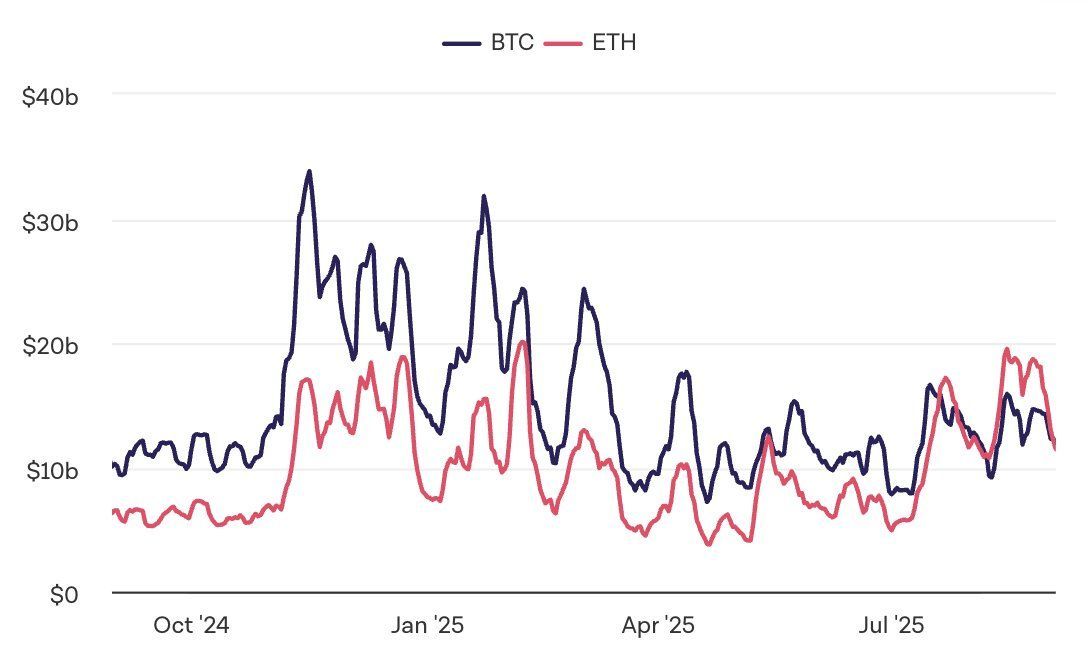


Carmelita
2025-09-04 16:37
🚨 Historic Shift on CEXs
Disclaimer:Contains third-party content. Not financial advice.
See Terms and Conditions.
➡️ Achat de 2,588 $BTC/USDT pour 258,8 M$ 🟢 ➡️ Vente de 35,009 $ETH/USDT pour 152,7 M$ 🔴
Un rééquilibrage massif qui en dit long sur leur vision court-terme du marché. 👀
#Bitcoin #Ethereum #cryptocurrency #blockchain



Carmelita
2025-09-04 13:11
🔥 Mouvement stratégique de BlackRock aujourd’hui
Disclaimer:Contains third-party content. Not financial advice.
See Terms and Conditions.
Risks and Challenges of Using Bitcoin: A Comprehensive Overview
Bitcoin has revolutionized the financial landscape since its creation in 2009, offering a decentralized alternative to traditional currencies. Its appeal lies in its potential for high returns, privacy features, and the promise of a borderless financial system. However, alongside these advantages come significant risks and challenges that investors and users must understand to navigate the crypto space effectively.
Financial Risks Associated with Bitcoin
One of the most prominent concerns surrounding Bitcoin is its extreme price volatility. Unlike fiat currencies backed by governments or commodities like gold, Bitcoin's value can fluctuate dramatically within short periods. For example, in recent years, it has experienced rapid surges followed by sharp declines—making it difficult for traders to predict future prices accurately. This volatility can lead to substantial financial losses for investors who buy at peak prices or sell during downturns.
Market manipulation is another risk stemming from the largely unregulated nature of cryptocurrency markets. Without comprehensive oversight from regulatory bodies like those governing traditional finance sectors, malicious actors can influence prices through tactics such as pump-and-dump schemes or coordinated trading activities. Such practices distort market signals and pose risks for retail investors unfamiliar with these manipulative strategies.
Regulatory uncertainty remains a critical challenge impacting Bitcoin’s stability and adoption rates. Governments worldwide are still formulating policies regarding cryptocurrencies; sudden regulatory changes—such as bans or stricter compliance requirements—can cause abrupt price drops or restrict access altogether. For instance, recent developments like the repeal of certain IRS rules on decentralized finance (DeFi) platforms have created both opportunities and uncertainties within this evolving legal landscape.
Investment Challenges When Using Bitcoin
Unlike traditional assets supported by institutions like banks or governments, Bitcoin lacks centralized backing that guarantees its value stability. This absence means that investor confidence heavily depends on market sentiment rather than intrinsic backing—a factor contributing to its high volatility.
Security concerns also pose significant hurdles for users engaging with Bitcoin transactions. While blockchain technology offers a secure ledger system resistant to tampering under ideal conditions, vulnerabilities exist elsewhere in the ecosystem—for example, through hacking exchanges or phishing scams targeting individual wallets. Recent incidents involving cyber espionage groups exploiting weaknesses highlight ongoing security threats faced by crypto users globally.
Furthermore, scams remain prevalent due to the decentralized nature of cryptocurrencies which makes regulation enforcement challenging. Fraudulent schemes such as fake investment platforms or Ponzi schemes lure unsuspecting investors into losing their funds without recourse—a stark reminder that due diligence is essential when dealing with digital assets.
Blockchain Technology Challenges Impacting Adoption
Bitcoin’s underlying blockchain technology faces several technical limitations affecting scalability and usability:
- Scalability Issues: The current infrastructure struggles under increasing transaction volumes; network congestion leads to slower processing times and higher fees during peak periods.
- Energy Consumption: Mining operations require substantial computational power—often consuming energy comparable to small countries—which raises environmental concerns amid global efforts toward sustainability.
- Interoperability Gaps: Limited compatibility between different blockchain networks hampers seamless asset transfers across platforms—a barrier for broader mainstream adoption where interoperability is key.
Addressing these technological challenges requires ongoing innovation within blockchain development communities but remains an obstacle until solutions are widely implemented.
Recent Developments Shaping the Crypto Landscape
The year 2025 has been pivotal in shaping perceptions around Bitcoin’s risks:
In April 2025, Bitcoin's price surged past $94,000 driven partly by increased inflows into exchange-traded funds (ETFs) and easing geopolitical tensions such as cooling-off periods related to trade conflicts.
Regulatory reforms marked a turning point when authorities repealed restrictive IRS rules concerning DeFi platforms; this move aimed at fostering innovation while balancing compliance demands.
Security threats persistently evolve: North Korean cyber spies reportedly established U.S.-based firms targeting cryptocurrency exchanges through sophisticated hacking campaigns—highlighting persistent cybersecurity vulnerabilities within crypto ecosystems.
These developments underscore how rapidly market dynamics shift based on technological advances and policy changes—and why staying informed is crucial for participants at all levels.
Potential Fallout from Current Risks
Given these intertwined risks—from market volatility to security breaches—the potential fallout could be severe:
Market Crashes: Sudden downturns triggered by regulatory crackdowns or large-scale sell-offs could wipe out significant portions of investor wealth.
Regulatory Clampdowns: Governments may impose stricter controls if they perceive cryptocurrencies threaten monetary systems’ stability—potentially leading to bans or restrictions that diminish usability.
Security Breaches Eroding Trust: Continued hacking incidents undermine confidence among users; diminished trust can slow adoption rates further impacting liquidity and valuation over time.
Understanding these possible outcomes helps stakeholders prepare contingency plans while advocating responsible regulation aligned with technological progress.
Navigating Risks: Best Practices for Users & Investors
To mitigate exposure:
- Conduct thorough research before investing—in particular understanding project fundamentals,
- Use reputable wallets & exchanges with robust security measures,3.. Stay updated on regulatory developments relevant in your jurisdiction,4.. Diversify holdings across different assets beyond just cryptocurrencies,5.. Be cautious about speculative investments driven solely by hype rather than fundamentals,
By adopting prudent strategies rooted in awareness of inherent risks—and leveraging trusted sources—you can better position yourself amidst an evolving crypto environment filled with both opportunity and peril.
Final Thoughts: Balancing Innovation With Caution
Bitcoin continues transforming how we think about money—but it does so amid complex challenges requiring careful consideration from all participants involved—from individual traders up to policymakers worldwide . Recognizing associated risks—including volatility fluctuations , security vulnerabilities , scalability hurdles ,and uncertain regulations—is essential not only for safeguarding investments but also fostering sustainable growth within this innovative sector .
Staying informed about recent developments ensures you’re prepared against potential fallout while contributing positively toward shaping responsible frameworks that support innovation without compromising safety standards.
Keywords: bitcoin risks , cryptocurrency challenges , blockchain scalability issues , crypto security threats , bitcoin regulation updates


JCUSER-IC8sJL1q
2025-05-06 08:13
What are the risks and challenges associated with using Bitcoin?
Risks and Challenges of Using Bitcoin: A Comprehensive Overview
Bitcoin has revolutionized the financial landscape since its creation in 2009, offering a decentralized alternative to traditional currencies. Its appeal lies in its potential for high returns, privacy features, and the promise of a borderless financial system. However, alongside these advantages come significant risks and challenges that investors and users must understand to navigate the crypto space effectively.
Financial Risks Associated with Bitcoin
One of the most prominent concerns surrounding Bitcoin is its extreme price volatility. Unlike fiat currencies backed by governments or commodities like gold, Bitcoin's value can fluctuate dramatically within short periods. For example, in recent years, it has experienced rapid surges followed by sharp declines—making it difficult for traders to predict future prices accurately. This volatility can lead to substantial financial losses for investors who buy at peak prices or sell during downturns.
Market manipulation is another risk stemming from the largely unregulated nature of cryptocurrency markets. Without comprehensive oversight from regulatory bodies like those governing traditional finance sectors, malicious actors can influence prices through tactics such as pump-and-dump schemes or coordinated trading activities. Such practices distort market signals and pose risks for retail investors unfamiliar with these manipulative strategies.
Regulatory uncertainty remains a critical challenge impacting Bitcoin’s stability and adoption rates. Governments worldwide are still formulating policies regarding cryptocurrencies; sudden regulatory changes—such as bans or stricter compliance requirements—can cause abrupt price drops or restrict access altogether. For instance, recent developments like the repeal of certain IRS rules on decentralized finance (DeFi) platforms have created both opportunities and uncertainties within this evolving legal landscape.
Investment Challenges When Using Bitcoin
Unlike traditional assets supported by institutions like banks or governments, Bitcoin lacks centralized backing that guarantees its value stability. This absence means that investor confidence heavily depends on market sentiment rather than intrinsic backing—a factor contributing to its high volatility.
Security concerns also pose significant hurdles for users engaging with Bitcoin transactions. While blockchain technology offers a secure ledger system resistant to tampering under ideal conditions, vulnerabilities exist elsewhere in the ecosystem—for example, through hacking exchanges or phishing scams targeting individual wallets. Recent incidents involving cyber espionage groups exploiting weaknesses highlight ongoing security threats faced by crypto users globally.
Furthermore, scams remain prevalent due to the decentralized nature of cryptocurrencies which makes regulation enforcement challenging. Fraudulent schemes such as fake investment platforms or Ponzi schemes lure unsuspecting investors into losing their funds without recourse—a stark reminder that due diligence is essential when dealing with digital assets.
Blockchain Technology Challenges Impacting Adoption
Bitcoin’s underlying blockchain technology faces several technical limitations affecting scalability and usability:
- Scalability Issues: The current infrastructure struggles under increasing transaction volumes; network congestion leads to slower processing times and higher fees during peak periods.
- Energy Consumption: Mining operations require substantial computational power—often consuming energy comparable to small countries—which raises environmental concerns amid global efforts toward sustainability.
- Interoperability Gaps: Limited compatibility between different blockchain networks hampers seamless asset transfers across platforms—a barrier for broader mainstream adoption where interoperability is key.
Addressing these technological challenges requires ongoing innovation within blockchain development communities but remains an obstacle until solutions are widely implemented.
Recent Developments Shaping the Crypto Landscape
The year 2025 has been pivotal in shaping perceptions around Bitcoin’s risks:
In April 2025, Bitcoin's price surged past $94,000 driven partly by increased inflows into exchange-traded funds (ETFs) and easing geopolitical tensions such as cooling-off periods related to trade conflicts.
Regulatory reforms marked a turning point when authorities repealed restrictive IRS rules concerning DeFi platforms; this move aimed at fostering innovation while balancing compliance demands.
Security threats persistently evolve: North Korean cyber spies reportedly established U.S.-based firms targeting cryptocurrency exchanges through sophisticated hacking campaigns—highlighting persistent cybersecurity vulnerabilities within crypto ecosystems.
These developments underscore how rapidly market dynamics shift based on technological advances and policy changes—and why staying informed is crucial for participants at all levels.
Potential Fallout from Current Risks
Given these intertwined risks—from market volatility to security breaches—the potential fallout could be severe:
Market Crashes: Sudden downturns triggered by regulatory crackdowns or large-scale sell-offs could wipe out significant portions of investor wealth.
Regulatory Clampdowns: Governments may impose stricter controls if they perceive cryptocurrencies threaten monetary systems’ stability—potentially leading to bans or restrictions that diminish usability.
Security Breaches Eroding Trust: Continued hacking incidents undermine confidence among users; diminished trust can slow adoption rates further impacting liquidity and valuation over time.
Understanding these possible outcomes helps stakeholders prepare contingency plans while advocating responsible regulation aligned with technological progress.
Navigating Risks: Best Practices for Users & Investors
To mitigate exposure:
- Conduct thorough research before investing—in particular understanding project fundamentals,
- Use reputable wallets & exchanges with robust security measures,3.. Stay updated on regulatory developments relevant in your jurisdiction,4.. Diversify holdings across different assets beyond just cryptocurrencies,5.. Be cautious about speculative investments driven solely by hype rather than fundamentals,
By adopting prudent strategies rooted in awareness of inherent risks—and leveraging trusted sources—you can better position yourself amidst an evolving crypto environment filled with both opportunity and peril.
Final Thoughts: Balancing Innovation With Caution
Bitcoin continues transforming how we think about money—but it does so amid complex challenges requiring careful consideration from all participants involved—from individual traders up to policymakers worldwide . Recognizing associated risks—including volatility fluctuations , security vulnerabilities , scalability hurdles ,and uncertain regulations—is essential not only for safeguarding investments but also fostering sustainable growth within this innovative sector .
Staying informed about recent developments ensures you’re prepared against potential fallout while contributing positively toward shaping responsible frameworks that support innovation without compromising safety standards.
Keywords: bitcoin risks , cryptocurrency challenges , blockchain scalability issues , crypto security threats , bitcoin regulation updates
Disclaimer:Contains third-party content. Not financial advice.
See Terms and Conditions.
Emerging Off-Chain Scaling Solutions for Bitcoin: Complementing the Lightning Network
Understanding Bitcoin Scalability Challenges
Bitcoin's decentralized architecture offers numerous advantages, including security and censorship resistance. However, these same features pose significant challenges when it comes to scalability. The limited block size (currently 1MB) and the need for every transaction to be recorded on the blockchain result in slower processing times and higher fees during periods of network congestion. This makes Bitcoin less practical for everyday transactions or micro-payments, which require quick confirmation times and low costs.
The Lightning Network: A Pioneering Solution
The Lightning Network (LN) has been at the forefront of addressing Bitcoin’s scalability issues. As a second-layer protocol built on top of the main blockchain, LN enables off-chain transactions through a network of bidirectional payment channels between users. These channels use smart contracts—specifically hash time-locked contracts (HTLCs)—to facilitate instant, low-cost transfers without recording each transaction on the blockchain immediately.
By routing payments through multiple nodes, LN significantly reduces congestion on the main chain, lowers transaction fees, and increases throughput capacity. Its design allows for near-instant settlement times suitable for small-value payments like tipping or point-of-sale transactions.
However, while LN is highly effective within its scope, it is not a catch-all solution. It faces limitations related to liquidity management across channels and potential security concerns in complex routing scenarios. Consequently, researchers are exploring additional off-chain solutions that can work alongside or extend beyond what LN offers.
Other Emerging Off-Chain Scaling Solutions
Bitcoin-Off-Chain Protocols (BOC)
One promising development is Bitcoin-Off-Chain (BOC), a protocol introduced around 2020 aimed at creating flexible off-chain transaction frameworks that can settle periodically on the main blockchain. Unlike LN’s primarily payment-channel focus, BOC employs state channels combined with hash time-locked contracts (HTLCs), enabling more complex interactions such as multi-party agreements or conditional transactions.
BOC's adaptability allows developers to tailor solutions based on specific needs—be it micro-payments or enterprise-level operations—making it a versatile complement to existing layer-two options like LN.
Raiden Network Adaptation for Bitcoin
Originally designed as an Ethereum-specific scaling solution similar to LN but optimized for ETH’s architecture, Raiden uses state channels and HTLCs to facilitate fast off-chain transfers between participants. Discussions are underway about adapting Raiden’s architecture for use with Bitcoin networks; if successful, this could introduce new functionalities such as improved channel management or enhanced privacy features within Bitcoin's ecosystem.
While still in experimental phases compared to mature protocols like LN or BOC, an adapted Raiden could diversify available tools by offering alternative routing mechanisms or better interoperability with other layer-two solutions.
Atomic Swaps: Cross-Cryptocurrency Liquidity Enhancement
Atomic swaps represent another innovative approach that enhances liquidity across different cryptocurrencies without relying on centralized exchanges. Using HTLC technology ensures trustless exchanges where both parties fulfill their obligations simultaneously before assets are released—a process known as atomicity.
This method not only facilitates direct peer-to-peer trading but also helps integrate various digital assets into broader ecosystems seamlessly—an essential feature given increasing adoption of altcoins alongside BTC. Atomic swaps thus contribute indirectly to scalability by reducing reliance on congested centralized exchanges and expanding decentralized trading options.
State Channels: High Throughput Off-Chain Transactions
State channels extend beyond simple payments by allowing multiple updates of application states off-chain before settling them collectively later onchain if needed. They leverage cryptographic techniques such as multi-signature schemes and commitment contracts to ensure security throughout interactions involving gaming platforms, decentralized finance applications (DeFi), or other high-frequency transactional environments within Bitcoin-compatible networks.
Recent technological advancements have improved state channel efficiency considerably since their inception around 2021–2023 — enabling rapid succession of transactions with minimal latency while maintaining robust security guarantees against fraud attempts during dispute resolutions.
Recent Developments in Off-Chain Solutions
Over recent years—from 2020 through 2023—the landscape of off-chain scaling technologies has seen significant progress:
- Bitcoin-Off-Chain Protocols have matured through extensive testing via testnets; pilot implementations hint at broader applicability beyond simple payment scenarios.
- Raiden Network, though primarily Ethereum-focused historically,
- discussions about adaptation suggest potential cross-platform benefits,
- promising new architectures could bring innovative features tailored specifically toward BTC.
- Atomic Swaps have gained traction among crypto communities due to their ability
- facilitate seamless cross-currency trades,
- reduce dependency on traditional exchanges,
- foster greater liquidity.
- State Channels continue evolving technologically:
- newer protocols enable more efficient batch processing,
- support complex smart contract logic outside main chains,
- improve overall throughput significantly.
How These Solutions Work Together
These emerging solutions do not operate in isolation; rather they form an interconnected ecosystem capable of addressing different facets of scalability:
- The Lightning Network excels at handling frequent small-value payments efficiently.
- State channels provide high-throughput environments suitable for applications requiring rapid updates.
- Atomic swaps enhance interoperability across diverse cryptocurrencies—broadening utility.
- Protocols like BOC offer flexible frameworks adaptable enough for various use cases beyond simple transfers.5.. Adaptations from projects like Raiden may introduce alternative routing strategies enhancing resilience against network failures or congestion points.
Implications For Future Growth Of Bitcoin Ecosystem
As these technologies mature—and potentially integrate—they promise several benefits:
- Increased Transaction Capacity — supporting higher volume without clogging main chains
- Lower Fees — making microtransactions economically viable
- Enhanced Privacy — especially when combined with advanced cryptographic techniques
- Greater Interoperability — fostering seamless exchange between different digital assets
- Broader Adoption — enabling use cases ranging from retail payments to enterprise integrations
Staying Ahead With Research And Development
To fully grasp how these emerging solutions will shape future bitcoin scalability strategies requires ongoing engagement with research papers—including whitepapers—and active participation within developer communities focused on layer-two innovations.
By continuously monitoring advancements from projects like BOC whitepapers—or developments related to adapting Raiden—or observing real-world deployment results from atomic swap platforms stakeholders can make informed decisions about integrating these tools into broader infrastructure plans.
In summary,
While the Lightning Network remains central in scaling efforts today,
the future lies in a diversified toolkit comprising protocols such as BOC,adapted versions of Raiden,atomic swaps,and state channels—all working synergistically—to create a more scalable , efficient,and user-friendly bitcoin ecosystem.


JCUSER-WVMdslBw
2025-05-14 19:15
What emerging off-chain scaling solutions complement Lightning Network for Bitcoin (BTC)?
Emerging Off-Chain Scaling Solutions for Bitcoin: Complementing the Lightning Network
Understanding Bitcoin Scalability Challenges
Bitcoin's decentralized architecture offers numerous advantages, including security and censorship resistance. However, these same features pose significant challenges when it comes to scalability. The limited block size (currently 1MB) and the need for every transaction to be recorded on the blockchain result in slower processing times and higher fees during periods of network congestion. This makes Bitcoin less practical for everyday transactions or micro-payments, which require quick confirmation times and low costs.
The Lightning Network: A Pioneering Solution
The Lightning Network (LN) has been at the forefront of addressing Bitcoin’s scalability issues. As a second-layer protocol built on top of the main blockchain, LN enables off-chain transactions through a network of bidirectional payment channels between users. These channels use smart contracts—specifically hash time-locked contracts (HTLCs)—to facilitate instant, low-cost transfers without recording each transaction on the blockchain immediately.
By routing payments through multiple nodes, LN significantly reduces congestion on the main chain, lowers transaction fees, and increases throughput capacity. Its design allows for near-instant settlement times suitable for small-value payments like tipping or point-of-sale transactions.
However, while LN is highly effective within its scope, it is not a catch-all solution. It faces limitations related to liquidity management across channels and potential security concerns in complex routing scenarios. Consequently, researchers are exploring additional off-chain solutions that can work alongside or extend beyond what LN offers.
Other Emerging Off-Chain Scaling Solutions
Bitcoin-Off-Chain Protocols (BOC)
One promising development is Bitcoin-Off-Chain (BOC), a protocol introduced around 2020 aimed at creating flexible off-chain transaction frameworks that can settle periodically on the main blockchain. Unlike LN’s primarily payment-channel focus, BOC employs state channels combined with hash time-locked contracts (HTLCs), enabling more complex interactions such as multi-party agreements or conditional transactions.
BOC's adaptability allows developers to tailor solutions based on specific needs—be it micro-payments or enterprise-level operations—making it a versatile complement to existing layer-two options like LN.
Raiden Network Adaptation for Bitcoin
Originally designed as an Ethereum-specific scaling solution similar to LN but optimized for ETH’s architecture, Raiden uses state channels and HTLCs to facilitate fast off-chain transfers between participants. Discussions are underway about adapting Raiden’s architecture for use with Bitcoin networks; if successful, this could introduce new functionalities such as improved channel management or enhanced privacy features within Bitcoin's ecosystem.
While still in experimental phases compared to mature protocols like LN or BOC, an adapted Raiden could diversify available tools by offering alternative routing mechanisms or better interoperability with other layer-two solutions.
Atomic Swaps: Cross-Cryptocurrency Liquidity Enhancement
Atomic swaps represent another innovative approach that enhances liquidity across different cryptocurrencies without relying on centralized exchanges. Using HTLC technology ensures trustless exchanges where both parties fulfill their obligations simultaneously before assets are released—a process known as atomicity.
This method not only facilitates direct peer-to-peer trading but also helps integrate various digital assets into broader ecosystems seamlessly—an essential feature given increasing adoption of altcoins alongside BTC. Atomic swaps thus contribute indirectly to scalability by reducing reliance on congested centralized exchanges and expanding decentralized trading options.
State Channels: High Throughput Off-Chain Transactions
State channels extend beyond simple payments by allowing multiple updates of application states off-chain before settling them collectively later onchain if needed. They leverage cryptographic techniques such as multi-signature schemes and commitment contracts to ensure security throughout interactions involving gaming platforms, decentralized finance applications (DeFi), or other high-frequency transactional environments within Bitcoin-compatible networks.
Recent technological advancements have improved state channel efficiency considerably since their inception around 2021–2023 — enabling rapid succession of transactions with minimal latency while maintaining robust security guarantees against fraud attempts during dispute resolutions.
Recent Developments in Off-Chain Solutions
Over recent years—from 2020 through 2023—the landscape of off-chain scaling technologies has seen significant progress:
- Bitcoin-Off-Chain Protocols have matured through extensive testing via testnets; pilot implementations hint at broader applicability beyond simple payment scenarios.
- Raiden Network, though primarily Ethereum-focused historically,
- discussions about adaptation suggest potential cross-platform benefits,
- promising new architectures could bring innovative features tailored specifically toward BTC.
- Atomic Swaps have gained traction among crypto communities due to their ability
- facilitate seamless cross-currency trades,
- reduce dependency on traditional exchanges,
- foster greater liquidity.
- State Channels continue evolving technologically:
- newer protocols enable more efficient batch processing,
- support complex smart contract logic outside main chains,
- improve overall throughput significantly.
How These Solutions Work Together
These emerging solutions do not operate in isolation; rather they form an interconnected ecosystem capable of addressing different facets of scalability:
- The Lightning Network excels at handling frequent small-value payments efficiently.
- State channels provide high-throughput environments suitable for applications requiring rapid updates.
- Atomic swaps enhance interoperability across diverse cryptocurrencies—broadening utility.
- Protocols like BOC offer flexible frameworks adaptable enough for various use cases beyond simple transfers.5.. Adaptations from projects like Raiden may introduce alternative routing strategies enhancing resilience against network failures or congestion points.
Implications For Future Growth Of Bitcoin Ecosystem
As these technologies mature—and potentially integrate—they promise several benefits:
- Increased Transaction Capacity — supporting higher volume without clogging main chains
- Lower Fees — making microtransactions economically viable
- Enhanced Privacy — especially when combined with advanced cryptographic techniques
- Greater Interoperability — fostering seamless exchange between different digital assets
- Broader Adoption — enabling use cases ranging from retail payments to enterprise integrations
Staying Ahead With Research And Development
To fully grasp how these emerging solutions will shape future bitcoin scalability strategies requires ongoing engagement with research papers—including whitepapers—and active participation within developer communities focused on layer-two innovations.
By continuously monitoring advancements from projects like BOC whitepapers—or developments related to adapting Raiden—or observing real-world deployment results from atomic swap platforms stakeholders can make informed decisions about integrating these tools into broader infrastructure plans.
In summary,
While the Lightning Network remains central in scaling efforts today,
the future lies in a diversified toolkit comprising protocols such as BOC,adapted versions of Raiden,atomic swaps,and state channels—all working synergistically—to create a more scalable , efficient,and user-friendly bitcoin ecosystem.
Disclaimer:Contains third-party content. Not financial advice.
See Terms and Conditions.
👉 Si ça se confirme, préparez-vous à une nouvelle vague de liquidités… et de volatilité.
#Bitcoin #financial markets
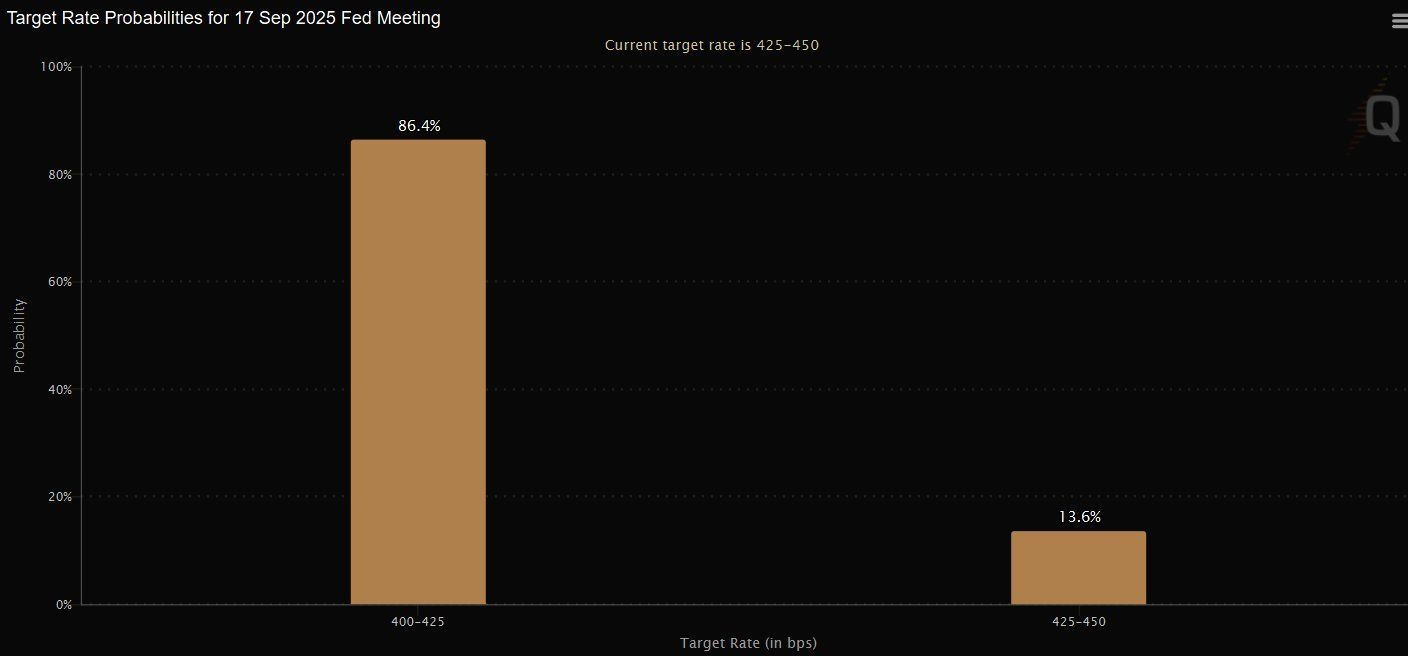


Carmelita
2025-08-31 17:08
⚡️INSIGHT: Le marché anticipe déjà à 86,4% une baisse des taux en septembre. 🔥
Disclaimer:Contains third-party content. Not financial advice.
See Terms and Conditions.
🎯 La concentration s’accélère : moins de mains, plus de pouvoir.
👉 Bonne ou mauvaise nouvelle pour l’avenir du réseau ?
#Bitcoin #crypto $BTC/USDT
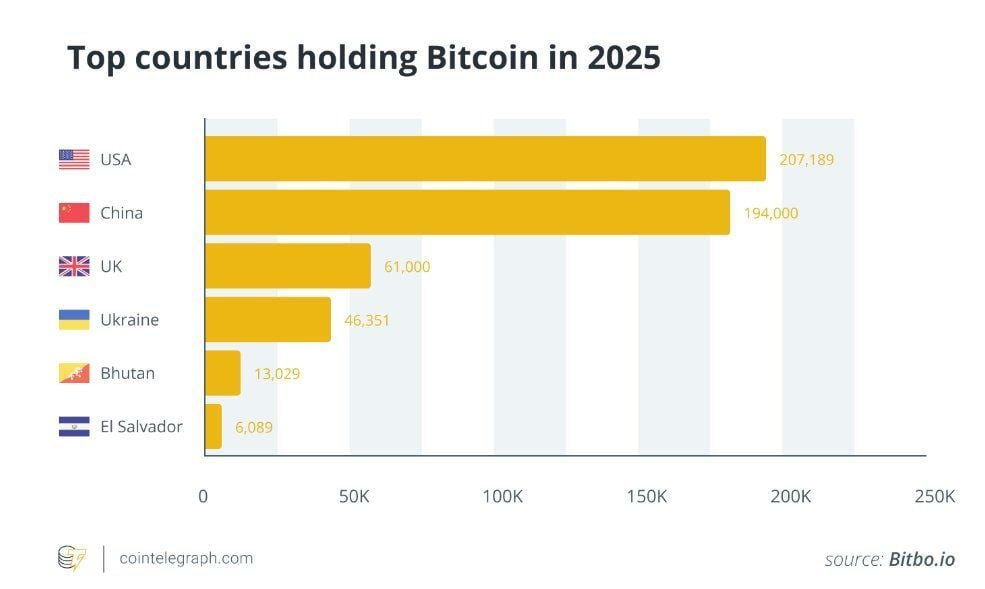


Carmelita
2025-08-31 17:10
UPDATE: Une seule stratégie détient désormais plus de $BTC que les 6 plus grands pays réunis.
Disclaimer:Contains third-party content. Not financial advice.
See Terms and Conditions.
Bitcoin Halving Explained: What It Is and Why It Matters for Investors
Understanding Bitcoin halving is essential for anyone interested in cryptocurrency investing or blockchain technology. This event, embedded within Bitcoin’s protocol, plays a crucial role in shaping the supply dynamics, market behavior, and long-term sustainability of the digital currency. In this article, we will explore what Bitcoin halving entails, its historical context, recent developments, and potential implications for miners and investors.
What Is Bitcoin Halving?
Bitcoin halving refers to a programmed event that reduces the reward miners receive for validating transactions by 50%. This process occurs approximately every four years or after every 210,000 blocks are mined. The primary purpose of halving is to control the issuance rate of new bitcoins entering circulation—ensuring scarcity over time while maintaining network security.
The mechanism was built into Bitcoin’s original code by its creator Satoshi Nakamoto as part of a deflationary monetary policy. By decreasing block rewards periodically, Bitcoin aims to mimic precious metals like gold—where limited supply drives value appreciation over time. Each halving effectively slows down new bitcoin creation until the maximum supply cap of 21 million coins is reached around the year 2140.
Historical Context: Past Halvings
Since its inception in 2009, Bitcoin has undergone three halvings:
- November 2012: The first halving reduced block rewards from 50 BTC to 25 BTC.
- July 2016: The second halving cut rewards further from 25 BTC to 12.5 BTC.
- May 2020: The third halving decreased rewards from 12.5 BTC to current levels at 6.25 BTC.
The upcoming event scheduled for May 2024 will reduce this reward again—from 6.25 BTC down to approximately 3.125 BTC per block.
Why Does Bitcoin Halving Matter?
Bitcoin's fixed issuance schedule makes halvings significant because they influence multiple aspects of the cryptocurrency ecosystem:
Supply Scarcity: Each halving decreases new bitcoin supply entering markets; fewer coins are created relative to demand potentially leading to price increases if demand remains steady or grows.
Market Volatility: Historically, halvings have been associated with increased price volatility due to speculative trading ahead of these events.
Miner Economics: Reduced rewards can impact mining profitability—especially for less efficient operations—potentially leading some miners out of business or prompting industry consolidation.
Network Security: Miners play a vital role in securing blockchain networks; if profitability drops significantly post-halving without corresponding increases in bitcoin prices or transaction fees, there could be concerns about network decentralization and security.
Recent Developments Leading Up To the Next Halving
The upcoming May 2024 event has garnered considerable attention within crypto communities and financial markets alike because it marks another milestone in Bitcoin's deflationary cycle:
The reduction from 6.25 BTC per block will bring it down again—to roughly 3.125 BTC.
Industry analysts anticipate potential market reactions such as price surges driven by investor anticipation or profit-taking behaviors preceding the event.
Mining companies like Argo Blockchain plc may face challenges maintaining profitability due to lower reward incentives unless bitcoin prices increase sufficiently post-halting.
This period also prompts discussions about how miners might adapt their operations—either through technological upgrades that improve efficiency or strategic shifts toward alternative revenue streams like transaction fees.
Impacts on Miners and Market Dynamics
A key concern surrounding halvings involves miner behavior:
As block rewards decrease sharply every four years (or after every set number of blocks), some less efficient mining operations may become unprofitable and exit the market—a process known as miner consolidation.
Conversely, higher bitcoin prices can offset reduced rewards by increasing revenue per coin mined; thus many investors watch price trends closely around these events.
Additionally, increased speculation often leads traders and investors into heightened activity during pre-halvings periods—a phenomenon contributing further volatility but also creating opportunities for strategic positioning.
How Investors Can Prepare
For those involved in cryptocurrency investment strategies—or simply seeking better understanding—the following points are worth considering:
- Monitor upcoming halvings closely since they tend historically toward significant market movements;
- Analyze broader macroeconomic factors influencing bitcoin’s price alongside technical indicators;
- Stay informed about industry developments affecting mining costs—including energy prices—and technological advancements;
- Diversify holdings across different assets within crypto portfolios as part of risk management strategies;
- Recognize that while past performance offers insights into potential trends post-halvings — no guarantee exists regarding future outcomes due solely based on historical patterns.
Semantic Keywords & Related Terms
To enhance search visibility and provide comprehensive coverage on this topic consider integrating keywords such as "bitcoin supply schedule," "cryptocurrency scarcity," "block reward reduction," "mining profitability," "crypto market volatility," "digital asset scarcity model," “halvening,” “bitcoin inflation rate,” “blockchain security,” among others throughout your content naturally without keyword stuffing.
Understanding Long-Term Implications
Bitcoin's protocol ensures that each subsequent halving reduces new coin issuance until reaching near-zero growth near maximum supply limits around mid-century—a feature designed not only for scarcity but also resilience against inflationary pressures common with traditional fiat currencies when central banks increase money supplies excessively.
This built-in scarcity mechanism underpins many long-term bullish narratives among crypto advocates who see halvings as catalysts driving sustained upward trends over extended periods despite short-term fluctuations caused by speculation or macroeconomic shocks.
In summary,
Bitcoin halting mechanisms serve both technical functions within blockchain architecture—and economic functions influencing global markets through controlled supply dynamics — making them pivotal moments worth tracking carefully whether you're an investor aiming at long-term growth prospects or an analyst studying digital asset fundamentals.


JCUSER-WVMdslBw
2025-05-14 08:59
What is Bitcoin’s halving, and why does it matter?
Bitcoin Halving Explained: What It Is and Why It Matters for Investors
Understanding Bitcoin halving is essential for anyone interested in cryptocurrency investing or blockchain technology. This event, embedded within Bitcoin’s protocol, plays a crucial role in shaping the supply dynamics, market behavior, and long-term sustainability of the digital currency. In this article, we will explore what Bitcoin halving entails, its historical context, recent developments, and potential implications for miners and investors.
What Is Bitcoin Halving?
Bitcoin halving refers to a programmed event that reduces the reward miners receive for validating transactions by 50%. This process occurs approximately every four years or after every 210,000 blocks are mined. The primary purpose of halving is to control the issuance rate of new bitcoins entering circulation—ensuring scarcity over time while maintaining network security.
The mechanism was built into Bitcoin’s original code by its creator Satoshi Nakamoto as part of a deflationary monetary policy. By decreasing block rewards periodically, Bitcoin aims to mimic precious metals like gold—where limited supply drives value appreciation over time. Each halving effectively slows down new bitcoin creation until the maximum supply cap of 21 million coins is reached around the year 2140.
Historical Context: Past Halvings
Since its inception in 2009, Bitcoin has undergone three halvings:
- November 2012: The first halving reduced block rewards from 50 BTC to 25 BTC.
- July 2016: The second halving cut rewards further from 25 BTC to 12.5 BTC.
- May 2020: The third halving decreased rewards from 12.5 BTC to current levels at 6.25 BTC.
The upcoming event scheduled for May 2024 will reduce this reward again—from 6.25 BTC down to approximately 3.125 BTC per block.
Why Does Bitcoin Halving Matter?
Bitcoin's fixed issuance schedule makes halvings significant because they influence multiple aspects of the cryptocurrency ecosystem:
Supply Scarcity: Each halving decreases new bitcoin supply entering markets; fewer coins are created relative to demand potentially leading to price increases if demand remains steady or grows.
Market Volatility: Historically, halvings have been associated with increased price volatility due to speculative trading ahead of these events.
Miner Economics: Reduced rewards can impact mining profitability—especially for less efficient operations—potentially leading some miners out of business or prompting industry consolidation.
Network Security: Miners play a vital role in securing blockchain networks; if profitability drops significantly post-halving without corresponding increases in bitcoin prices or transaction fees, there could be concerns about network decentralization and security.
Recent Developments Leading Up To the Next Halving
The upcoming May 2024 event has garnered considerable attention within crypto communities and financial markets alike because it marks another milestone in Bitcoin's deflationary cycle:
The reduction from 6.25 BTC per block will bring it down again—to roughly 3.125 BTC.
Industry analysts anticipate potential market reactions such as price surges driven by investor anticipation or profit-taking behaviors preceding the event.
Mining companies like Argo Blockchain plc may face challenges maintaining profitability due to lower reward incentives unless bitcoin prices increase sufficiently post-halting.
This period also prompts discussions about how miners might adapt their operations—either through technological upgrades that improve efficiency or strategic shifts toward alternative revenue streams like transaction fees.
Impacts on Miners and Market Dynamics
A key concern surrounding halvings involves miner behavior:
As block rewards decrease sharply every four years (or after every set number of blocks), some less efficient mining operations may become unprofitable and exit the market—a process known as miner consolidation.
Conversely, higher bitcoin prices can offset reduced rewards by increasing revenue per coin mined; thus many investors watch price trends closely around these events.
Additionally, increased speculation often leads traders and investors into heightened activity during pre-halvings periods—a phenomenon contributing further volatility but also creating opportunities for strategic positioning.
How Investors Can Prepare
For those involved in cryptocurrency investment strategies—or simply seeking better understanding—the following points are worth considering:
- Monitor upcoming halvings closely since they tend historically toward significant market movements;
- Analyze broader macroeconomic factors influencing bitcoin’s price alongside technical indicators;
- Stay informed about industry developments affecting mining costs—including energy prices—and technological advancements;
- Diversify holdings across different assets within crypto portfolios as part of risk management strategies;
- Recognize that while past performance offers insights into potential trends post-halvings — no guarantee exists regarding future outcomes due solely based on historical patterns.
Semantic Keywords & Related Terms
To enhance search visibility and provide comprehensive coverage on this topic consider integrating keywords such as "bitcoin supply schedule," "cryptocurrency scarcity," "block reward reduction," "mining profitability," "crypto market volatility," "digital asset scarcity model," “halvening,” “bitcoin inflation rate,” “blockchain security,” among others throughout your content naturally without keyword stuffing.
Understanding Long-Term Implications
Bitcoin's protocol ensures that each subsequent halving reduces new coin issuance until reaching near-zero growth near maximum supply limits around mid-century—a feature designed not only for scarcity but also resilience against inflationary pressures common with traditional fiat currencies when central banks increase money supplies excessively.
This built-in scarcity mechanism underpins many long-term bullish narratives among crypto advocates who see halvings as catalysts driving sustained upward trends over extended periods despite short-term fluctuations caused by speculation or macroeconomic shocks.
In summary,
Bitcoin halting mechanisms serve both technical functions within blockchain architecture—and economic functions influencing global markets through controlled supply dynamics — making them pivotal moments worth tracking carefully whether you're an investor aiming at long-term growth prospects or an analyst studying digital asset fundamentals.
Disclaimer:Contains third-party content. Not financial advice.
See Terms and Conditions.
Le ratio atteint un niveau critique, un signal historique observé seulement 2 fois depuis le dernier bear market. 📊 👉 À surveiller de près pour anticiper un possible rebond.
#Bitcoin #CryptoSignals #cryptocurrency #blockchain
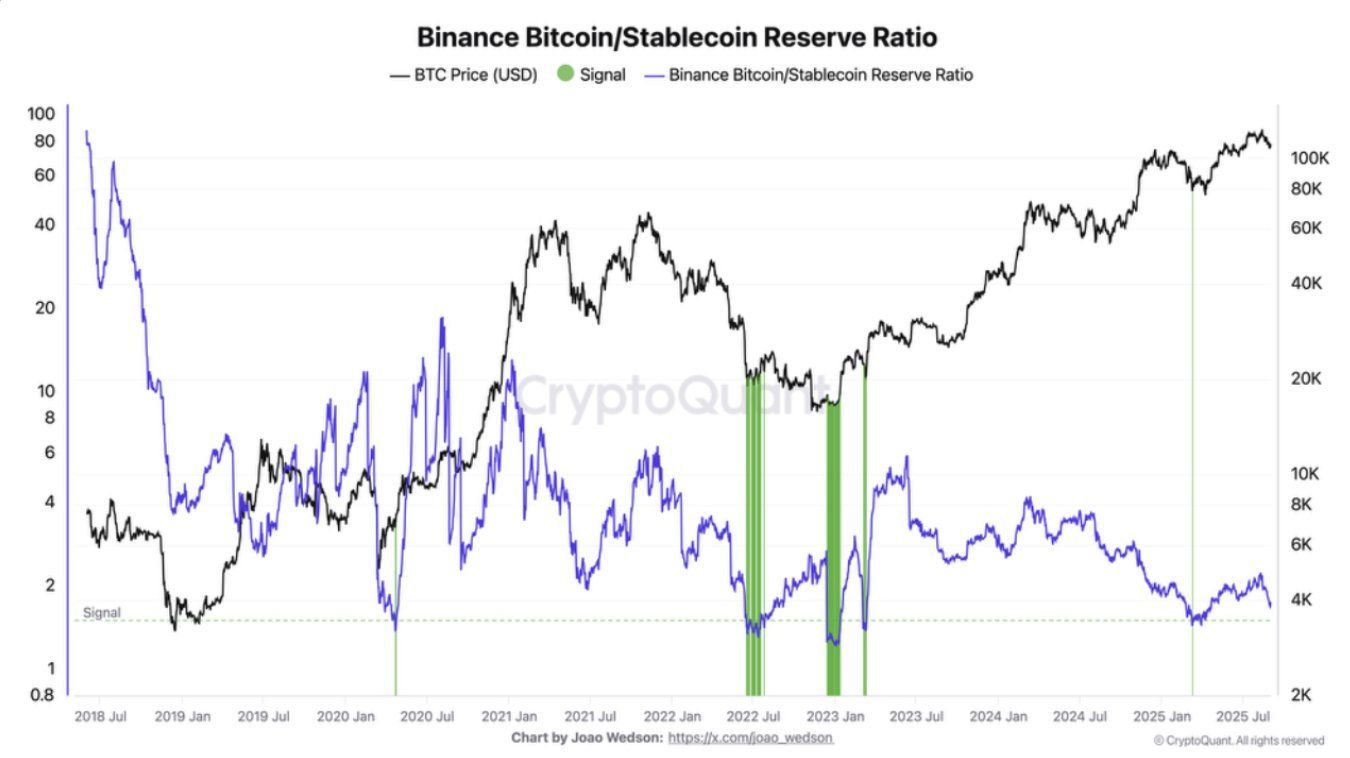


Carmelita
2025-09-04 17:05
🚨 Alerte Binance : Réserve $BTC vs stablecoins au bord du signal d’achat rare
Disclaimer:Contains third-party content. Not financial advice.
See Terms and Conditions.